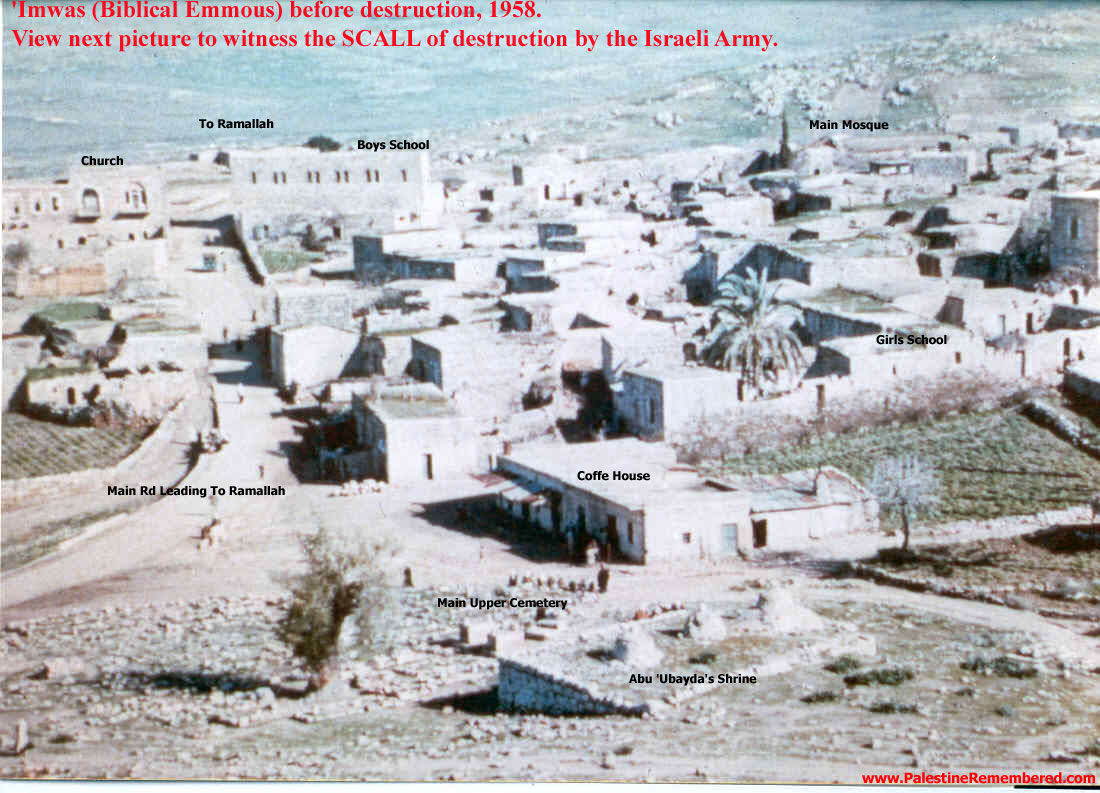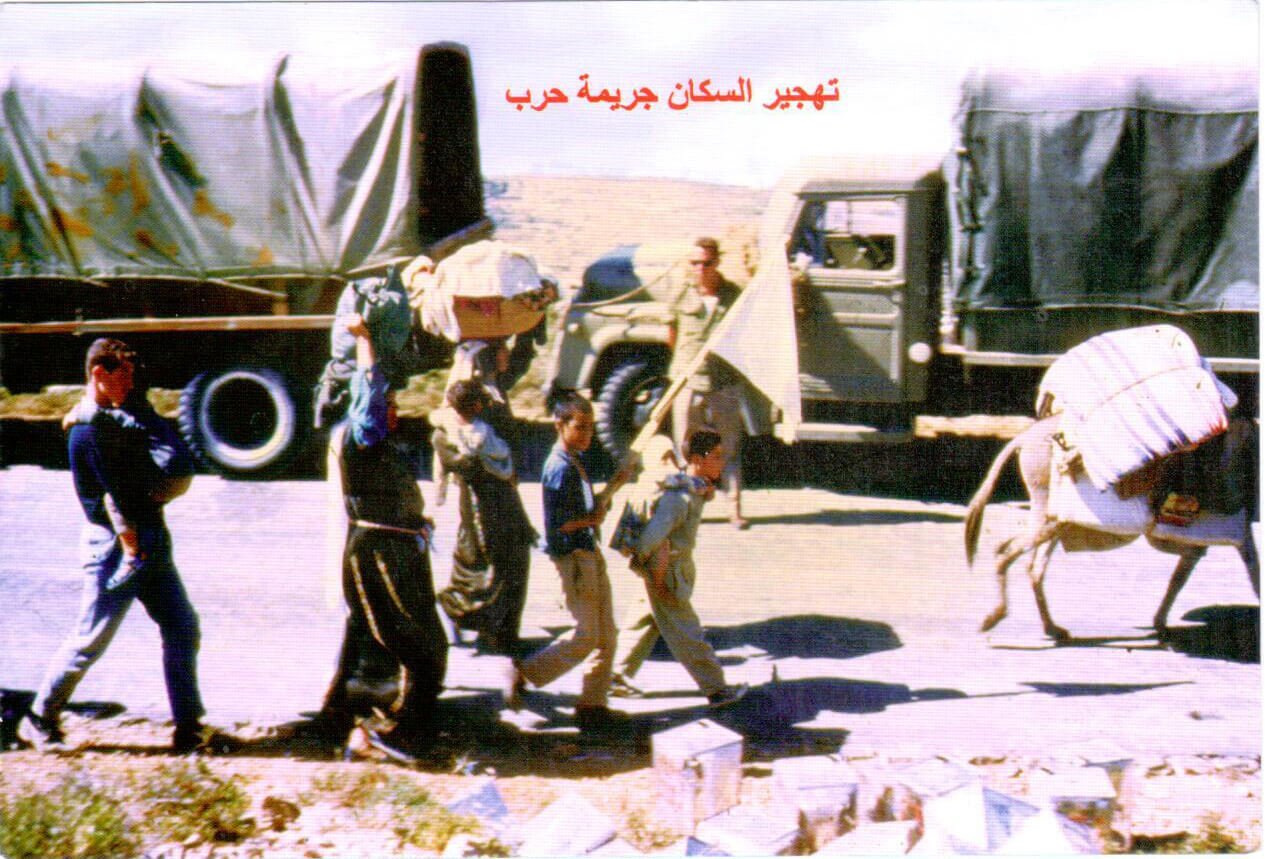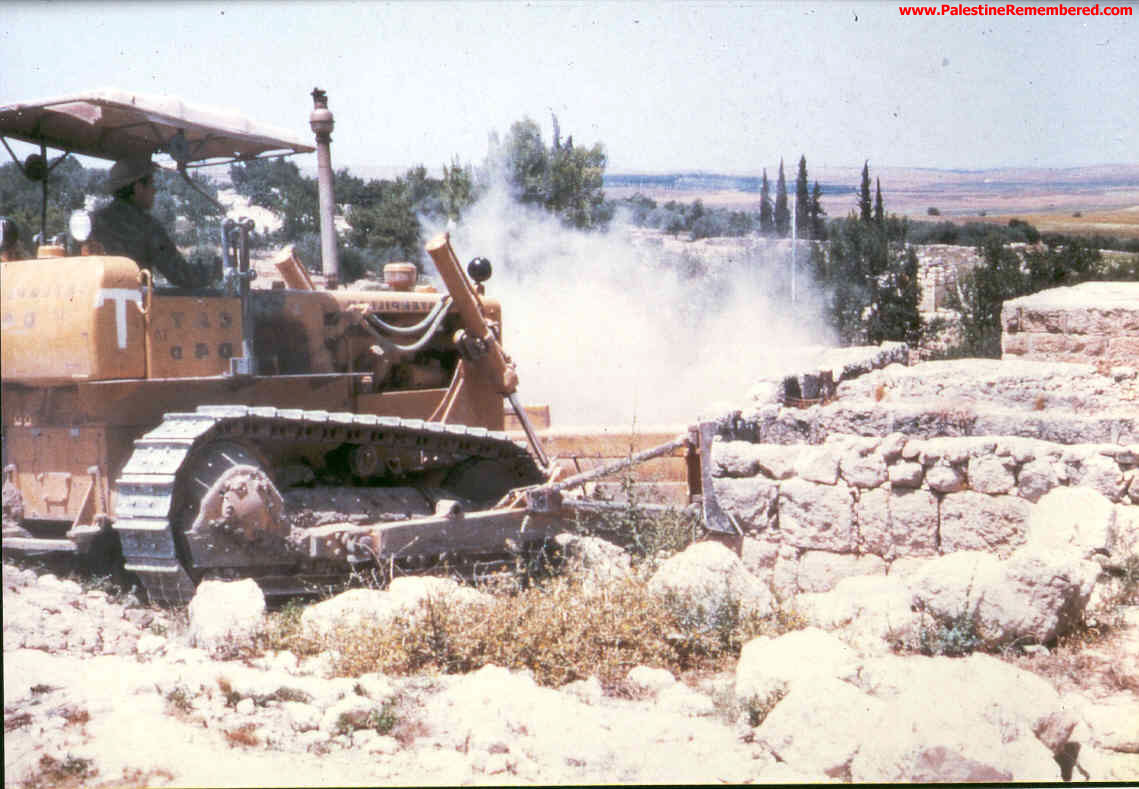The Infamy Called "Canada Park"
A Story of Dispossession and Suffering

Canada Park is a national park built on top of three ethnically
cleansed Palestinian villages.
I was born, in 1933, in the village of Beit Nuba in Palestine, where I was brought up and lived happily with family and friends. The village of Beit Nuba had existed for thousands of years, as historic records show. However, Israeli wars of aggression and war crimes made its recent history painful and tragic.
In May 1948, the Israeli army launched an attack to occupy the villages of Imwas [Emmaus], Yalu and Beit Nuba, but failed to conquer these villages. Elsewhere, in Palestine, the Zionist terrorist gangs and the Israeli army were committing massacres against the predominantly unarmed Palestinian people and conducted their long-planned campaign of ethnic cleansing of the Palestinian people from their homeland. There was one day, out of many during that conflict, that left painful sights in my life. It was on July 10, 1948 that Israeli army troops, led by Yitzhak Rabin, occupied the Palestinian cities of Lydda and Ramleh. Rabin and his officers proceeded to drive these 50-60,000 civilian inhabitants of these two cities away from their homes in terror, with low-flying airplanes over their heads shooting the occasional person and forcing them to run. The sight of the terror-stricken, hungry and thirsty men, women and children fleeing in terror in the midday sun of the hot summer, having run approximately twenty-five kilometres to the village of Beit Nuba, where I, a 15 year old boy, saw them with my own eyes, is a sight not to be forgotten.
The defeat of the Israeli army and its failure to occupy these
three villages, in May 1948, brought about a brutal revenge 19
years later in the war of aggression that Israel planned and
effected on June 5, 1967 against its Arab neighbours. On June 6,
these three villages were occupied, without a single shot being
fired, and were systematically dynamited and bulldozed, on the
direct orders of Yitzhak Rabin, the then chief of staff of the
Israeli army. The villagers, over 10,000, were expelled from
their land. In the village of Beit Nuba, 18 were buried alive
under the ruins of their homes because they were old or infirm
and unable to move out of their homes before they were
demolished. One of them, Mohammad Ali Baker, was an uncle of my
mother. When our home was demolished, my uncle, who was old and
arthritic, was slow to move out, the Israeli soldiers told him,
while they were demolishing the western part of our home, that
he will be buried alive if he did not move when they will be
soon demolishing the eastern part of our home. He was hurriedly
moved out. The pain and suffering that my mother sustained was
immense and continued to feel until her dying day. My mother,
brother, sisters and my uncle were driven out from our land and
never allowed to return, and I continue to bear that pain.

 Imwas in 1958 (left) and in 1968 (right),
after being razed by the Zionists.
Imwas in 1958 (left) and in 1968 (right),
after being razed by the Zionists.


Palestinians are expelled from Imwas by the Israeli military,
which bulldozes their homes.
The destruction of these three villages in June 1967 was described, in the CBC documentary below, as an act of revenge, by General Narkiss the commander of the Israeli forces that demolished these villages.
The destruction of these villages was witnessed and described by the Israeli journalist Amos Kenan, who was a reserve soldier in the occupying force in Beit Nuba. He gave this account to the Israeli newspaper Ha'Olam Hazeh, which was prohibited by the censor from publishing it. It was sent to all members of the Knesset, and to the Israeli Prime Minister and Defence minister, but no response was received.
"The unit commander told us that it had been decided to blow up three villages in our sector; they were Beit Nuba, Imwas and Yalu ... We were told to block the entrances of the villages and prevent inhabitants [from] returning .... The order was to shoot over their heads and tell them not to enter the village.
"Beit Nuba is built of fine quarry stones; some of the houses are magnificent. Every house is surrounded by an orchard, olive trees, apricots, vines and cypresses. They are well kept. Among the trees, there are carefully tended vegetable beds.
"At noon the first bulldozer arrived and pulled down the first house at the edge of the village. Within ten minutes the house was turned into rubble. The olive trees and cypresses were all uprooted. After the destruction of three houses, the first refugee column arrived from the direction of Ramallah. We did not fire in the air. There were old people who could hardly walk, murmuring old women, mothers carrying babies, small children. The children wept and asked for water. They all carried white flags.
"We told them to go to Beit Sira. They told us they had been driven out. They had been wandering like this for four days, without food, some dying on the road. They asked to return to their village ... Some had a goat, a lamb, a donkey or a camel. A father ground wheat by hand to feed his four children .... The children cried. Some of our soldiers started crying too.
"We went to fetch the Arabs some water. We stopped a car with a major, two captains and a woman ... We asked the officers why these refugees were sent from one place to another and driven out of everywhere. They told us that this was good for them, they should go. 'Moreover,' said the officers, 'what do we care about the Arabs anyway?'"
"We drove them out. They go on wandering like lost cattle. The weak die. Our unit was outraged. The refugees gnashed their teeth when they saw the bulldozers pull down the trees. None of us understood how Jews could behave like this. No one understood why these fellaheen [villagers] shouldn't be allowed to take blankets and some food.
"The chickens and doves were buried in the rubble. The fields were turned into wasteland in front of our eyes. The children who went crying on the road will be fedayeen in nineteen years, in the next round. Thus we have lost the victory." (From Israel Imperial News, March 1968.)
Uri Avnery, then a Knesset member, described the destruction of these villages as a definite war crime. This was carried out on the direct orders of Yitzhak Rabin, then Chief of Staff of Israel's armed forces. These acts are in direct violation of The Fourth Geneva Convention, 1949, to which Israel is a signatory. Article 53 of the convention states: " Any destruction by the Occupying Power of real or personal property, belonging individually or collectively to private persons, or to the state, or to other public authorities or social or cooperative organizations, is prohibited."
It is now difficult to spot the ruins and the rubble. Today
there stands on the site of the ruins of these three village,
Imwas [the biblical village Emmaus, where Jesus Christ first
appeared after his Resurrection to meet with his Apostles],
Yalu and Beit Nuba, the infamy called "Canada Park", with
picnic areas for Israelis, built with Canadian tax-deductible
dollars provided by the Canadian Jewish National Fund (JNF), a
registered Canadian charity. [TML emphasis]
It was in 1973 that Bernard Bloomfield of Montreal, then President of the JNF of Canada, spearheaded a campaign among the Canadian Jewish community to raise $15 million to establish Canada Park, so as to provide a picnic area accessible to Israelis from Jerusalem and Tel Aviv.
At the entrance of Canada Park, just off John Diefenbaker Parkway (opened by Diefenbaker himself in 1975), is a sign that reads: "Welcome to Canada Park in Ayalon Valley -- a project of the Jewish National Fund of Canada."
The JNF, responsible for the upkeep of the park, has removed all signs of the villages and their inhabitants from the area. It would seem that only the Canadian donors are worthy of being remembered; their names are engraved in the bronze plaques which cover an entire wall. Interestingly, these donors are not directly informed that the park is built on the site of the demolished villages. The Director of the American JNF stated that, "It is a delicate situation, and one cannot expect an institution [such as the Canadian JNF] which gathers money from abroad, to publicise the issue [of the demolition of these villages]." ("Canada Park: A Case Study," by Ehud Meltz and Michal Selah, Kol Hair, Aug. 31, 1984.)
The glossy guidebook, published by the JNF of Canada, has an entire page devoted to the history of the area, including the biblical, Roman, Crusader and British periods, but has no mention of these villages or their destruction. Another step in the obliteration of the villages from memory can be seen in their absence from Israeli maps.
As a new Canadian, my personal pain was compounded when I read on Dec. 4, 1978, in our local newspaper, The Halifax Herald, that Peter Herschorn, a prominent Halifax businessman and past chairman of the Atlantic branch of the JNF, was honored by the JNF for his humanitarian work and "choosing the right goodness" in his participation in the building of Canada Park. The Lieutenant-Governor of Nova Scotia, the Premier of NS and the Mayor of Halifax were in attendance and offered their greetings. I was mortified that political leaders in my new country, Canada, would consider the erection of recreation centres on the site of ruins of criminally demolished peaceful villages, illegally occupied, as a humanitarian act.
When I was invited to come to Canada to teach at Dalhousie
University Medical School, I accepted with enthusiasm, as I had
a vision of Canada as a country of liberal values upholding
human rights and international law. However, the story of our
government, allowing our tax dollars to be used to build this
infamy of Canada Park, a war crime, has been a source of torment
and pain for me. Over many years, I have written repeatedly,
supported by some honourable politicians like Senator Heath
Macquarrie and Mr. R.A. Corbett, MP, to successive Revenue
Canada Ministers, expressing concern about this, and receiving
only vague unhelpful answers. It was in the midst of this that
the Canadian Broadcasting Corporation, Fifth Estate
program prepared and broadcast a documentary on Canada Park,
titled: "Park with no Peace," broadcast on Oct. 21, 1991. This
deserves to be viewed and studied by all.
In summation, I stand before you today, to express gratitude to The Canadian Museum for Human Rights for agreeing to listen to my story exposing the violation of my human rights and to express the pain and suffering of the Palestinian people who were systematically expelled from their homeland and continue to live as refugees denied the fundamental right of return to their homes, a right clearly stipulated in the Universal Declaration of Human Rights and repeated UN resolutions. As Israel continues to defy international law and to compound our agony, we witness deafening silence from countries, like Canada, which claim to uphold the UN Charter and universal human rights. To compound that, I, as a Canadian citizen, feel, with pain and shame, the complicity of my country in continuing to subsidize this war crime, sadly called Canada Park, defaming Canada's name.
Canada Park -- "Park with No Peace"
This article was published in

Volume
54 Number 33 - May 15, 2024
Article Link:
https://cpcml.ca/Tmlm2024/Articles/MS54334.HTM
Website: www.cpcml.ca Email: editor@cpcml.ca


